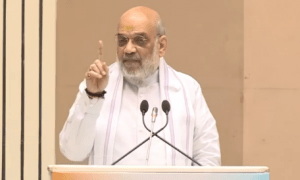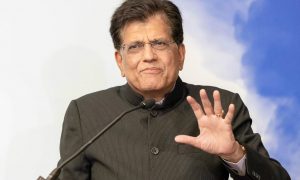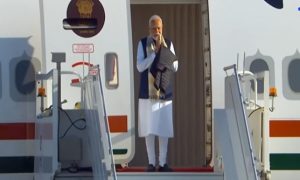All eyes were on the Federal Reserve’s show in this blockbuster week, yet while he delivered the widely-anticipated cut to interest rates Chairman Jerome Powell still disappointed investors hoping he would signal more aggressive easing to come.
The first Fed cut since 2008 also did little to quell worries about lingering trade frictions — which heated up Thursday with a new threat from the U.S. — or to drown out a fresh round of weak data led by bad news out of Europe.
Here’s our weekly wrap of what’s going on in the world economy:
Full-On Fed
The most highly anticipated Fed decision of the year yielded few surprises, yet markets didn’t quite get what they wanted and stocks dropped. Powell’s line on the reduction not being the start of a long series of cuts spooked investors — even as he insisted that didn’t mean this necessarily is a one-cut deal, either. That sticking point is a further sign that Fed decisions will remain high-pressured for the markets at least through year’s end.
The Powell messages that were more well-received:
Nevertheless, President Donald Trump, of course, wasn’t pleased.
Now What
Now that the Fed has pulled the rate-cut trigger, further dovishness could be due globally. The Bank of Japan held policy Tuesday while signaling more willingness to add to easing, and elsewhere in Asia central bankers probably will be slower to follow the Fed on the way down than they were to follow it up.
Brazil’s wasted no time, adding a half-point cut into the mix Wednesday and pledging to do more for an ailing economy. Policy makers in the Gulf weren’t far behind, while the Fed wrong-footed the few remaining hawkish central banks.
Governments are still leaning hard on rate setters — another ominous sign of waning firepower for the next global downturn, as Bloomberg Economics analysis shows. Mexico’s President Andres Manuel Lopez Obrador told Bloomberg he’d like more interest-rate cuts and Russia’s economic minister issuing an unusual warning about central bank inaction.
Same Old
Trump rattled the financial markets anew Thursday, issuing a threat to install another round of tariffs on China for alleged inaction on U.S. soybean purchases and the flow of fentanyl into the U.S.
The series of tweets further killed the mood of U.S.-China talks this week, which met an anti-climactic end with a plan to regroup in early September. This round always had a rocky feel to it, despite a waterfront dinner and jazz nostalgia. Trump — who had recently voiced support for President Xi Jinping in the latter’s struggle to contain Hong Kong protests — broke his silence to call out China for a “rip off” and charging China and other self-declared developing countries with cheating via WTO preferences. Beijing, for its part, pledged ahead of the talks to “effectively deal with trade frictions” in the second half of the year.
Asia’s still feeling the pain acutely, the July PMIs showed. Factory gauges in China and Japan added more bad news, and the export-heavy small economies of Singapore and Hong Kong are seeing storm clouds ahead. The U.S. is no longer a happy exception to the gloom and doom on our Bloomberg Trade Tracker.
Japan’s removal of South Korea from a list of trusted export destinations can’t help matters.
Old World Problems
It was a rough week for Europe, with data roundly adding gloom to the outlook and prompting Bloomberg Economics to see big stimulus coming from the European Central Bank in September. Growth and inflation hit the brakes, confidence wilted. The continent’s growth engine, Germany, saw an unemployment uptick while Bloomberg analysts project July saw a deeper growth contraction there. France and Spain added disappointments. And sterling’s slump is unlikely to carry a silver lining for the economy this time.
Europe wasn’t entirely alone, with sluggish animal spirits in India and housing increasingly out of reach for many Americans.


























 WhatsApp us
WhatsApp us